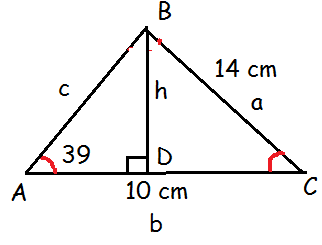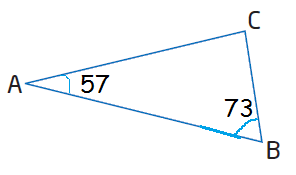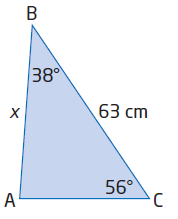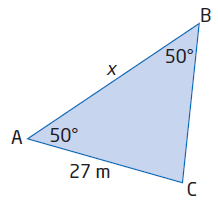HOW TO TELL IF A TRIANGLE HAS ONE TWO OR NO SOLUTIONS
Subscribe to our ▶️ YouTube channel 🔴 for the latest videos, updates, and tips.
When solving a triangle, you must analyse the given information to determine if a solution exists. If you are given the measures of two angles and one side (ASA), then the triangle is uniquely defined. However, if you are given two sides and an angle opposite one of those sides (SSA), the ambiguous case may occur. In the ambiguous case, there are three possible outcomes:
- No triangle exists that has the given measures; there is no solution
- One triangle exists that has the given measures; there is one solution
- Two distinct triangles exist that have the given measures; there are two distinct solutions.
For the ambiguous case in triangle ABC, when ∠A is an acute angle:
- a ≥ b one solution
- a = h one solution
- a < h no solution,
- b sin A < a < b two solutions
Where h = b sin A
For the ambiguous case in triangle ABC, when ∠A is an obtuse angle:
- a ≤ b no solution
- a > b one solution
Question :
For each triangle, determine whether there is no solution, one solution, or two solutions.
a) In triangle ABC, ∠A = 39°, a = 10 cm, and b = 14 cm.
Solution :

a/sin A = b/ sin B = c/sin C
14/sin 39 = 10/sin B = c/sin C
14/0.6293 = 10/sin B
22.24 = 10/sin B
sin B = 10/22.24 = 0.4496
B = 27 (approximately)
<A + <B + <C = 180
39 + 27 + <C = 180
<C = 180 - 66
<C = 114
sin A = Opposite side / Hypotenuse side
sin 39 = h/c
h = c sin 39

AB = c = 24 cm, BC = a, AC = b, <A = 57 and <B = 73
In triangle ABC,
<A + <B + <C = 180
57 + 73 + <C = 180
<C = 180 - 130 = 50
Using sin formula,
a/sin A = b/sin B = c/sin C
a/sin 57 = b/sin 73 = 24/sin 50
We have to solve for b.
Equating 1 and 3, we get
b/sin 73 = 24/sin 50
b/0.9563 = 24/0.7660
b = 31.33(0.9563)
b = 29.96
b = 30 cm (approximately)
Hence the indicated side is 30 cm.
b) In triangle ABC, ∠B = 38°, ∠C = 56°, and BC = 63 cm. Find the length of AB.
Solution :

AB = c, BC = a = 63, AC = b, <C = 56 and <B = 38
In triangle ABC,
<A + <B + <C = 180
<A + 38 + 56 = 180
<A = 180 - 94 = 86
Using sin formula,
a/sin A = b/sin B = c/sin C
63/sin 86 = b/sin 38 = c/sin 56
We have to solve for c.
Equating 1 and 3, we get
63/sin 86 = c/sin 56
63/0.9975 = c/0.8290
63.15 = c/0.8290
c = 63.15(0.8290)
c = 52.35
c = 52.4 cm (approximately)
Hence the indicated side is 52.4 cm.
c) In triangle ABC, ∠A = 50°, ∠B = 50°, and AC = 27 m. Find the length of AB.

Solution :
AB = c, BC = a = 27 m, AC = b = 27 m, <A = 50 and <B = 50
In triangle ABC,
<A + <B + <C = 180
50 + 50 + <C = 180
<C = 180 - 100 = 80
Using sin formula,
a/sin A = b/sin B = c/sin C
27/sin 50 = 27/sin 50 = c/sin 80
We have to solve for c.
Equating 1 and 3, we get
27/sin 50 = c/sin 80
27/0.7660 = c/0.9848
35.24 = c/0.9848
c = 35.24(0.9848)
c = 34.70 m
Hence the indicated side is 34.7 m.
Subscribe to our ▶️ YouTube channel 🔴 for the latest videos, updates, and tips.
Kindly mail your feedback to v4formath@gmail.com
We always appreciate your feedback.
About Us | Contact Us | Privacy Policy
©All rights reserved. onlinemath4all.com
Recent Articles
-
AP Calculus BC Problems with Solutions
Dec 20, 25 10:51 AM
AP Calculus BC Problems with Solutions -
AP Precalculus Problems and Solutions (Part - 1)
Dec 20, 25 10:49 AM
AP Precalculus Problems and Solutions (Part - 1) -
AP Calculus AB Problems with Solutions (Part - 1)
Dec 20, 25 10:49 AM
AP Calculus AB Problems with Solutions (Part - 1)
